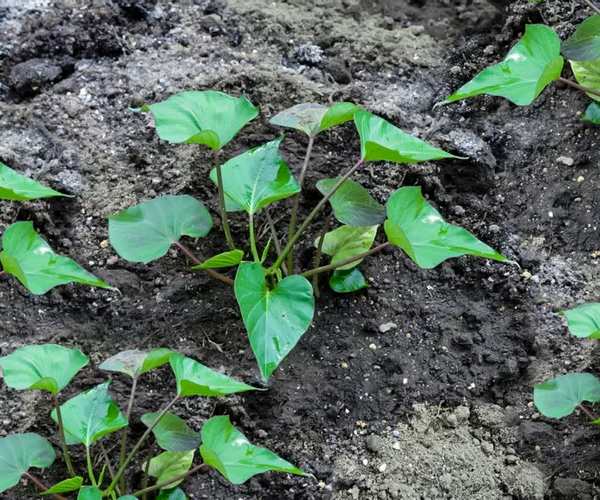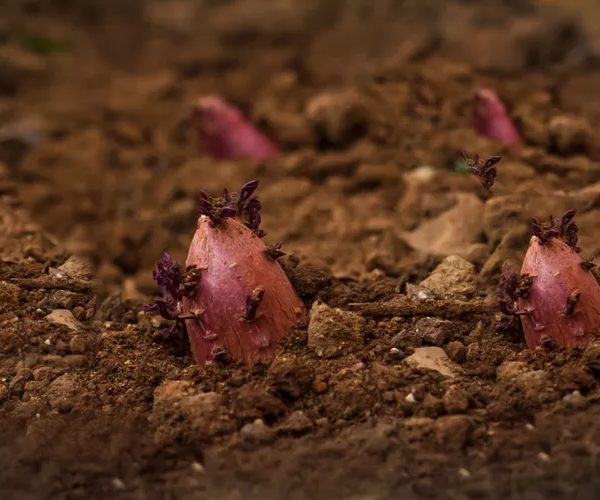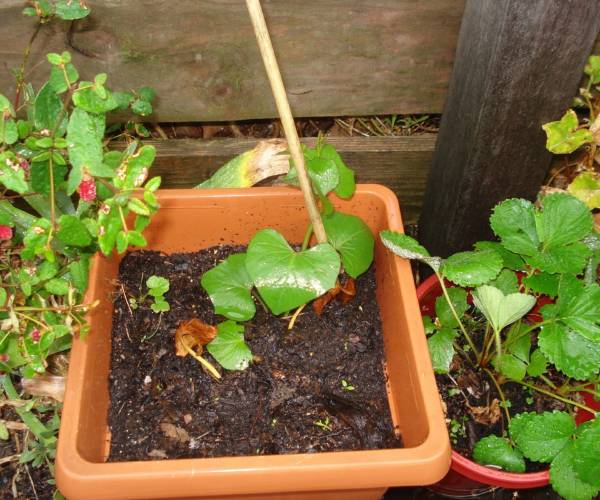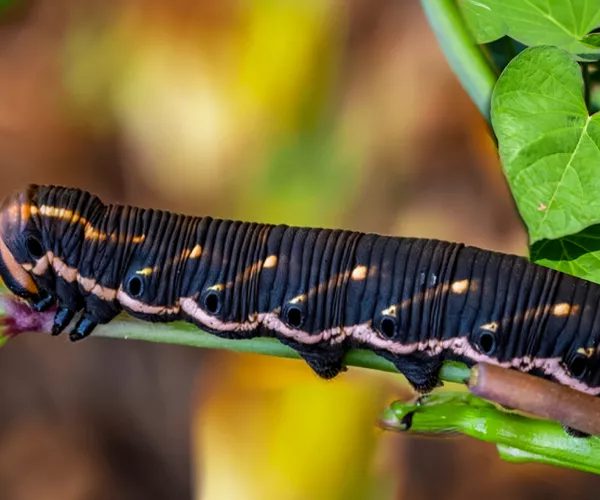One thing you must know before growing sweet potatoes is that they are not at all related to regular potatoes and aren’t developed the same way. Unlike the potatoes we regularly eat, you can not plant a whole sweet potato in the ground and expect a crop as it will rot underground. Sweet potatoes are grown from sweet potato slips. If you don’t know what stems are, they are the stems and foliage that sprout from already-grown sweet potatoes. You have to twist them, root them in water, and then plant them. In just three to four months, you should have some healthy sweet potatoes.
You should always plant sweet potatoes in the spring. These slow-growers need warm temperatures to develop full-size tubers. There are usually three to five tubers per plant and you’ll get even more if you live in warmer climates. These veggies come back every year in the warmer growing zone (USDA zones 8 through 11). Usually, orange-fleshed sweet potatoes are the most popular but a sweet potato can also be white, yellow, and even purple. If you want to grow sweet potatoes in your garden but have a smaller garden, go for a bush variety.
Plant Attributes
- Common Name: Sweet Potato
- Botanical Name: Ipomoea batatas
- Family: Convolvulaceae
- Plant Type: Herbaceous, perennial, annual
- Mature Size: 2-20 ft. long
- Sun Exposure: Full sun, part shade
- Soil Type: Well-drained, sandy
- Soil pH: Acidic
- Bloom Time: Summer
- Hardiness Zones: 8-11 (USDA)
- Native Areas: North America, South America
How to Plant Sweet Potatoes
When to Plant
These plants are tropical by nature so it is necessary to wait until the soil has warmed up fully in spring before you plant it.

Normally, sweet potatoes are planted in raised rows, about 8 inches high. This is done as it helps the soil warm faster and also keeps them well-drained. If you plant it in a cooler climate, spread black plastic on the soil as it helps it warm faster.
Also, Read What is Variegated Plants? Here’s What You Need to Know!
Selecting a Planting Site
Sweet potatoes can thrive in any soil if it is well-drained and in a sunny location. If your soil is too rocky or thick, try planting them in raised beds that are filled with sandy but rich potting soil.
Spacing, Depth, and Support
To grow your sweet potatoes, plant the slips about 12 to 18 inches apart with 3 to 4 feet between rows. The vines will spread and fill in, so you need to give them plenty of space.
How to Care for Sweet Potatoes
Light
Ensure that you plant your sweet potatoes in full sun or partial shade. These veggies generally prefer full sun but like some afternoon shade in hot and dry regions.

Soil
As we mentioned earlier, sweet potatoes are like soil that is well-drained but has high organic matter. It prefers sandier soil to dense, clay soil.
Water
Once established, sweet potatoes can tolerate dry soil. Until then, it is recommended to give them 1 inch of water once a week and keep them evenly moist. Prevent watering them during the last three to four weeks before harvesting to prevent mature tubers from breaking or splitting. Water frequently and keep the plants moist mainly during dry seasons.
Temperature and Humidity
Do not plant sweet potatoes outdoors until the temperature of the soil is 60 degrees Fahrenheit. They require soil-growing temperatures between 60 to 85 degrees Fahrenheit and an air-growing temperature of 65 to 95 degrees Fahrenheit. If you live in the northern part of the country, choose short-season varieties.
Fertilizer
Sweet potatoes are normally not heavy feeders but they require balanced nutrition, especially during proper soil preparation. Overfeeding will only promote the growth of foliage rather than tubers. It is best to add compost to the beds before planting them. Also, you can add an organic liquid fertilizer to the soil before planting.
Types of Sweet Potatoes
- ‘Beauregard’: This famous commercial variety produces a potato with pale reddish skin and dark orange flesh that takes 100 days to mature.
- ‘Bush Porto Rico‘: This compact vine grows a potato with copper skin and orange flesh after 110 days. This variety has big yields, so it’s a good choice if you have a smaller garden.
- ‘Centennial‘: This cultivar has good disease resistance and quickly matures, averaging about 90 days to maturity.
- ‘Georgia Jet‘: Another fast-maturing variety, ‘Georgia Jet’ is popular for its reddish skin and orange flesh; it matures in about 3 months.
- ‘Patriot‘: This outstanding pest resistance variety is a popular choice for organic gardens. The potatoes have copper skin and orange flesh.
Sweet Potatoes vs. Sweet Potato Vines
While sweet potatoes are commonly grown in the southern United States, they will grow in just about any garden in any part of the world. The part that we consume is the tuberous root of this warm-weather perennial vining plant. Edible parts of sweet potatoes are somehow related to morning glories (Ipomoea tricolor) and are the same species as the sweet potato vining plants commonly grown as ornamentals. The edible and ornamental types are different cultivars of Ipomoea batatas.
Harvesting Sweet Potatoes
The tubers should be ready to consume just three to four months after planting, depending on the cultivar. If you prefer eating the leaves as greens, you can do that in a moderate amount. However, be sure to leave enough leaves to keep the plant growing.
Once the foliage turns yellow, you can dig up the tubers. If the foliage is hit by a frost, don’t worry, the tubers will most likely be still fine. You shouldn’t let them just sit in the ground for too long after the tops die back otherwise they will start to rot. While digging, be gentle. Since the tubers grow very close to the surface, their skins are tender and can be damaged and bruised easily.
Also, Read Top 10 Poisonous Plants to Keep Out of Your Garden for Dog’s Safety
Grow Sweet Potatoes in Containers
If you want to experiment with growing edible sweet potatoes then it is best to do so by starting them off in containers. They are super easy to grow in containers. Start by purchasing small plants in the spring or grow slips in pots. Take a large container of any material that has enough drainage holes and fill it in with high-quality potting soil. If you’re confused about the size, a half-whisky barrel is the proper size. Make a hole that is large enough to cover the roots of your plant or slip. Water the planting thoroughly and keep the pot in a sunny pot. It is necessary to water them properly at least once a week unless it rains.

While you can try growing sweet potatoes indoors, it is very challenging. The outcome is normally smaller even after a four-month wait. They need a lot of sun, heat, and water which is very hard to maintain indoors.
Pruning
The vines of sweet potatoes will grow in a rambling way but they shouldn’t be pruned since they are important to help feed the potatoes. If your vines are growing out of control, you can just use your hands to turn the vines back toward the garden.
Propagating Sweet Potatoes
Propagating these healthy veggies with slips or by saving tubers for replanting is a great option. If you keep a sweet potato in water, you will not get more potatoes. However, you will get slips that you can plant to get more sweet potatoes. If you live in an area where winters are longer, you can simply save tubers over the winter and plant them in the coming spring. If the winters are short, you can simply start new slips from vine cuttings or whole potatoes.
Overwintering
Overwintering sweet potatoes is just like propagating them for the coming growing season. Before the arrival of the first fall frost, cut the vines to the ground. Then, carefully dig up tubers using a shovel and gently brush the soil from the tubers. Now is the time to store them in a box filled with dry material. Make sure the tubers are not touching and keep the box in a cool, dry place where the tubers won’t freeze. Cover the box completely to make sure that no light reaches the tubers.
Common Pests and Plant Diseases
While growing sweet potatoes at home, wireworms, and root-knots nematodes are the biggest problems. If you rotate the crop, there will likely be less damage. You can avoid many problems by opting for disease-resistant varieties and using certified disease-free sweet potato slips. Mice can also be a problem, so be careful.

FAQs
Q: Are sweet potatoes easy to grow?
A: Sweet potatoes are surprisingly easy to grow. Since the vines root wherever they touch the ground, a few plants can easily produce a generous harvest.
Q: Can you plant sweet potatoes indoors?
A: Growing edible sweet potatoes requires warm weather and a large container with a lot of drainage holes; In other words, it can become quite messy to grow sweet potatoes indoors. Sweet potato plants also tend to become root-bound in smaller pots, so it’s best to grow them outdoors in bigger containers or on the ground.
Q: Can I plant a garden of sweet potatoes with varieties from the grocery store?
A: Sweet potatoes grown for consumption are usually planted from purchased slips—small rooted pieces of a tuber—or from tubers that you can root at home. You can try growing sweet potatoes from the grocery store, but the only way to be certain you have certified disease-free roots is to buy slips from a reputable seed supplier.
